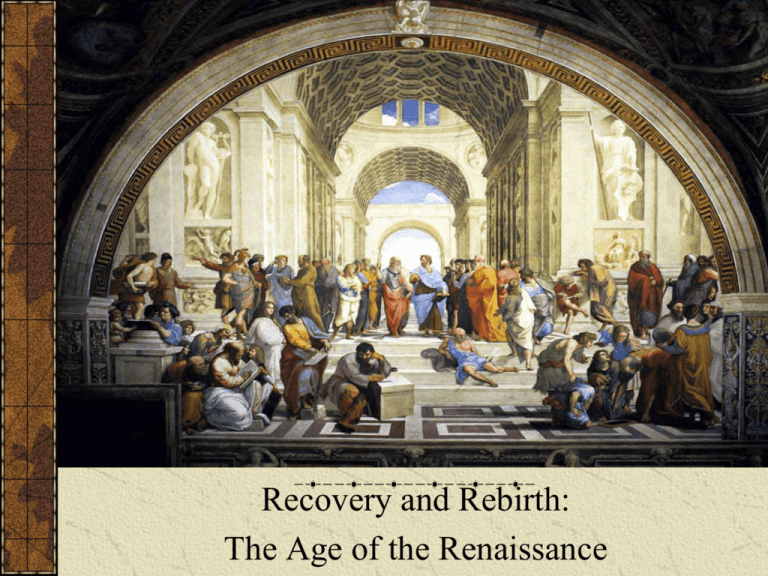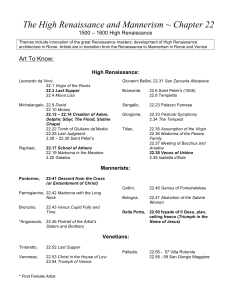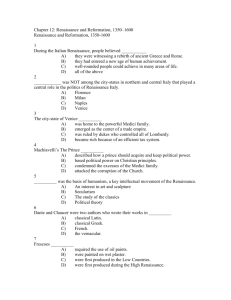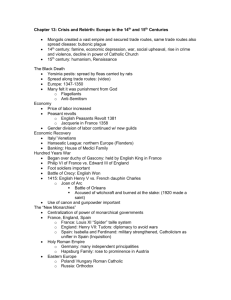Renaissance Lecture
advertisement

Recovery and Rebirth: The Age of the Renaissance Characteristics & Meaning of Renaissance Recovery from 14th C Essentially urban phenomenon Rediscovery of classical antiquity Emphasis on individual ability Economic Recovery Italian cities lose preeminence due to Plague Hanseatic League grow in power Compete w/ Med city-states Textile industry rivaled by printing, mining, & metallurgy Venetians cont’d development of commercial empire Banking flourishes in Florence w/ new profits from textiles Social Changes in the Renaissance The Nobility 2 - 3 % of population Military & political posts Concession from centralizing rulers More costs & less profits of 14th C Education: Key to advancement Baldassare Castiglione • The Book of the Courtier Service to the prince Modest, but proud? Classical ed Impeccable character (nobles born w/ grace) Martial skill Peasants and Townspeople 85-90% of population (Rising econ + new ag techniques) x plague costs = (Decline of manorialism + cont’d erosion of serfdom) Lords found more profitable to hire workers Social Stratification in Cities Peasants as hired workers After ruin of plague, towns grew in pop Social status in cities developed & grew Patricians: old $, commercial banking; dominated local govt Petty burghers: artisans, shopkeepers, guild masters/members Property-less workers Unemployed 30-40% of pop Slavery in the Renaissance Ag slavery declines, largely replaced by serfdom by 9th C Reappears in 11th C; grows rapidly, esp. after BD steals workers Skilled workers needed in Italy Household workers wanted across Europe Concubines for wealthy patricians Obtained from the eastern Med, Black Sea region, Africa, & Spain Wars b/t Christians & Muslims bring fresh infidels” to each side Declines in Italy by end of 15th century (except in royal courts) Portuguese import 140,000 from Africa between 1444 and 1505 Replace European slaves The Family in Renaissance Italy Extended in nature Multi-generational living Often almost like communes (families w/ parents in large villas Usually echoed feudal order • Autocratic Father center of family • Mother over females; usually much younger • Eldest brother replaces; Eldest wife Marriages Arranged for social & econ advance Role of the wife Primary role to bear children High mortality rates childbirth, infancy, & early childhood Italian States of Renaissance Era Five most powerful city-states: Milan Venice Florence Naples Papal States ©2003 Wadsworth, a division of Thomson Learning, Inc. Thomson Learning™ is a trademark used herein under license. Five Major States Duchy of Milan Prior to 1447, ruled by Visconti family Briefly repub before former condittiero Francesco Sforza claimed control by marrying Visconti daughter & paid HRE for title Highly organized & profitable tax & govt admin Controlled Lombardy Republic of Venice Maritime powerhouse Controlled northwestern Italy & Western Adriatic Borghesia-aristocrat oligarchy govt Commercial empire Elected Doge (dux) acted as chief admin Fear of Venice led to Florentine-Milanese alliance Republic of Florence Dominated Tuscany @start of 15th C, controlled by borghesian oligarchy 1434: Cosimo Medici assumes control Kept appearance of repub, but ran govt as “grey eminence” Thru LAVISH patronage of arts, made Florence center of Renaissance G i o v a n n i B i c c i C o s i m o L o r e n z o Medici Hall of Fame G i u l i a n i G i o v a n n i G i u l i o Giovanni di Bicci Masaccio & Brunelleschi Cosimo Lorenzo Florence Under the Medici As power grew, all pretense of oligarchy (let alone democracy) fell Cosimo content to be grey eminence; Piero sickly, Lorenzo powerful, but generous Exiled under Piero II (1494-1512); restored to power in 1530 After Lorenzo’s death, Girolamo Savonarola came to power establishing a republic/theocracy Botticelli renounced painting Weirdly, Pico della Mirandola was a friend Condemnations of Pope Alex VI resulted in his death Medici assumed power again under Alessandro II (Il Moro) A New Generation Rises After Allessandro’s murder by a cousin, a junior branch of Medici (children of Cosimo’s brother Lorenzo) assumed control of Florence under Cosimo I, Duke of Tuscany (1537) This line would rule for 200 years (when a Hapsburg family that married into the Medici would take over) Independent City-States Independent City-States Urbino Federico da Montefeltro, (14441482) Took over after brother died, but continued in his profession as condottiero Fought for Milan, Florence, Ferrara Made Urbino into a Renaissance center- second largest library Named Duke of Urbino by pope Sixtus, named Gonfaliere of the Church (mil cdr) Surgeons removed bridge of his nose after a fight- improved line of sight for left eye Mantua Controlled by Gonzaga family Married into Paleologi family Also condottieri even after rise Isabella d’Este (1474-1539) ruled after hubby Francesco died. First woman of Renaissance Accomplished musician, Greek & Latin scholar Patron of arts • Leonardo • Titian • Raphael Ferrara Warfare in Italy Wars in Lombardy: 1425-1454 Venice v. Milan Peace of Lodi: 1454 Balance of power • Milan, Florence, & Naples allied against Venice & Papal States Troubles w/ Spain & France France dominated Naples & Milan Francis I • Allied with Pope & Suleiman Aragon (later Spain) allied w/ remaining citystates Carlos I (aka Charles V) sacked Rome Had Naples, 2 Sicilies; got Milan back after Pavia Birth of Modern Diplomacy For smaller city-states to survive, resident agents sent to other city states Due to influence of France/Spain, agents sent to other countries Ambassadors developed from this In 16th & 17th C, mod dip practices developed Rights of ambassadors Procedures for conducting int’l affairs Machiavelli and the New Statecraft Niccolò Machiavelli (1469-1527) The Prince • Political power to restore and maintain order • Humanity is self-centered • Ends justifies the means Based his work on life of Cesare Borgia Dedicated it to Medici Currying favor b/c they had previously exiled him Duke of Valentinois, Duke of Romagna, Prince of Andria and Venafro, Count of Dyois, Lord of Piombino, Camerino, and Urbino, Gonfalonier of the Church Captain General of the Church, Bishop of Pamplona Cardinal of Valencia Italian Renaissance Humanism Liberal arts (grammar, rhetoric, poetry, moral philosophy, and history) Emergence of Humanism • Petrarch (1304-1374) Rejected scholastic philosophy Emphasize classics Humanism in 15th C Italy • Leonardo Bruni (1370-1444) Civic humanism Lorenzo Valla (1407-1457) • Literary criticism of ancient texts Poggio Bracciolini (1380-1459) • Criticism of the church Humanism and Philosophy Marsilio Ficino (1433-99) Synthesis of Christianity & Platonism Florentine Platonic Academy Hermeticism Occult sciences Theological and philosophical beliefs and speculation Pico della Mirandola (1463-94) Common nuggets of universal truth Education in the Renaissance Vittorino da Feltre (13781446) Humanist education Pietro Paolo Vergerio (1370-1444) Liberal arts education History, moral philosophy, rhetoric, letters (grammar and logic), poetry, mathematics, astronomy, and music Women “Renaissance man” Humanism and History Secularism of history Miracles downplayed Natural causation Francesco Guicciardini (1483-1540) Modern analytical historiography History of Italy & History of Florence Impact of Printing Johannes Gutenberg Movable metal type, 14451450 Bible, 1455 or 1456 Spread rapidly Venice alone home to 1k printers Development of scholarly research Lay reading public 50% religious in nature Latin/Greek classics Romances grew increasingly popular The Artistic Renaissance Early Renaissance Masaccio (1401-1428) Frescos Paolo Uccello (13971475) Laws of perspective Sandro Botticelli (1445-1510) • Greek and Roman mythology Donato di Donatello (1386-1466) • David Filippo Brunelleschi (1377-1446) • Architecture Piero della Francesca (c. 1410-1492) • Portraits The High Renaissance Leonardo da Vinci (1452-1519) Realism and idealism Raphael (1483-1520) Ideal of beauty Michelangelo (1475-1564) • Divine beauty Donato Bramante (1444-1514) • Architecture Artist and Social Status Artist as hero Financial gains The Northern Artistic Renaissance Jan van Eyck (1390?-1441) • Oil paint and varied range of colors Albrecht Dürer (1471-1528) • Perspective and proportion Music in the Renaissance Guillaume Dufay (c. 1400-1474) • Change in the composition of the mass Madrigal (poem set to music) The European State in the Renaissance The “New Monarchies” Concentration of authority Suppression of the nobility Control of the church Loyalty of the People The Growth of the French Monarchy Charles VII, 1422-1461 • Taille (annual direct tax) • Pragmatic Sanction of Bourges, 1438 Louis XI, 1461-1483 • Charles the Bold, duke of Burgundy, 1467-1477 • Commerce ©2003 Wadsworth, a division of Thomson Learning, Inc. Thomson Learning™ is a trademark used herein under license. Burgundy Under Charles the Bold Europe in the Renaissance ©2003 Wadsworth, a division of Thomson Learning, Inc. Thomson Learning™ is a trademark used herein under license. England: Civil War and a New Monarchy War of the Roses, 1450s-1485 Henry VII, 1485-1509, Tudors • • • • Abolished “livery and maintenance” Court of Star Chamber Income Commerce Unification of Spain Isabella of Castile, 1474-1504 Ferdinand of Aragon, 1479-1516 Cortes Hermandades The Iberian Peninsula ©2003 Wadsworth, a division of Thomson Learning, Inc. Thomson Learning™ is a trademark used herein under license. Corregidores The Church Jews and Muslims • Inquisition Granada, 1492 Expulsion of Jews and Muslims The Holy Roman Empire: The Success of the Habsburgs Frederick III, 1440-1493 Maximilian I, 1493-1519 Southeastern Europe ©2003 Wadsworth, a division of Thomson Learning, Inc. Thomson Learning™ is a trademark used herein under license. Struggle for a Strong Monarchy in Eastern Europe Poland Hungary Russia Ottoman Turks and the End of the Byzantine Empire Spread of the Seljuk Turks, 13th century Constantinople falls, 1453 The Church in the Renaissance The Problems of Heresy and Reform John Wyclif (c. 1328-1384) • No basis of papal claims for temporal authority • Lollards John Hus (1374-1415) • Calls for end of worldliness and corruption of the clergy Council of Constance, 1414-1418 • Sacrosancta (council received authority from God) • Frequens (regular holding of councils) Pope Pius II – Execrabilis (condemned appeals to a council over the head of the pope is heretical) The Renaissance Papacy Pope Julius II, 1503-1513 • Warrior pope • Basilica of Saint Peter Pope Sixtus, 1474-1484 • Nepotism Pope Alexander VI, 1492-1503 • Debauchery and sensuality Pope Leo X, 1513-1521 • Patron of the arts





